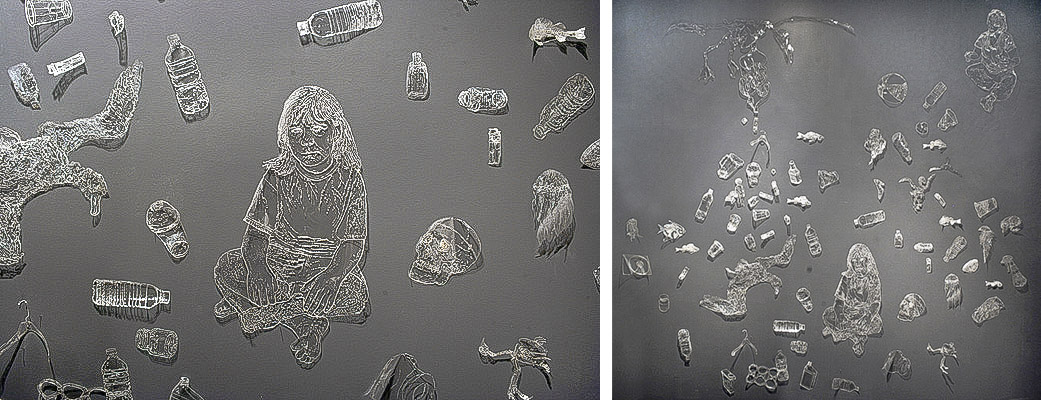
21st Century Albatross
Bethany Taylor, 2008
Adaptable wall installation comprised of engraved drawings on recycled plastic
Museum of Arts and Sciences, Macon, Georgia
Photos: Craig Coleman. Courtesy of the artist © 2008.

21st Century Albatross (details)
Bethany Taylor, 2008
Adaptable wall installation comprised of engraved drawings on recycled plastic
Museum of Arts and Sciences, Macon, Georgia
Left photo: Craig Coleman, Right photo: courtesy of the artist © 2008
About the Artist
Bethany Taylor confronts her plastic demons in a series of engraved drawings, entitled “21st Century Albatross.” With impressive detail, Taylor carves recycled plastic into depictions of post-consumer trash, including beverage bottles and cups, discarded lighters, disposable cameras and toys. Amid these items, she places engravings of dead seabirds and fish, a human skull and an engraving of her daughter. By including her daughter within this vortex of plastic, Taylor acknowledges her own role in this global problem and alludes to the difficulty of weaning ourselves off plastic goods and packaging. But she also asks us to consider the burden we place on future generations, including her daughter, by failing to control our obsession with plastic.
Explore These Artworks
In the artist’s words:
“21st Century Albatross was inspired by research on the enormous amount of plastics collecting in ocean gyres. I collect, crush and transform recycled plastic into engraved drawings of dead and gutted marine birds spewing plastic waste items from their bellies. Meanwhile I imagine myself implicated in the narrative as I simultaneously dump plastic garbage onto my own daughter.”
From Earth Day Network:
This artwork is inspired by the growing problem of plastic debris in our oceans. We address the importance of recovering and reusing materials in the following excerpt from our blog. You can view the full blog posthere.
Food waste, coffee grounds and tea bags, soiled paper, and yard trimmings and used napkins are a great example of useful “waste.” These materials can be composted to produce valuable soil amendments that can be used in gardens, agriculture, soil restoration, and erosion and sediment control. However, even being known as a still valuable resource, food waste represents the largest percentage of waste going to landfills (21% of the discarded material in 2013, according to EPA).
Understanding the importance of recovering and using this material, as well as the educational potential of that practice, some schools have developed composting in school programs. These programs show students that things that they would usually through in the trash bin can help to grow new food; they can change the view of waste as something “out of sight out of mind” since students are in direct contact with it and become aware that it does not simply disappear when taken from curbside bins. Composting in schools is a growing trend amongenvironmental educators and can be found in cities like Cleveland, O.H., Eugene and Lane County, O.R., and Baltimore, M.D. – where a pilot project implemented in elementary and middle schools was responsible for diverting 34,525 pounds of waste from landfills and incinerators. The benefits of school composting programs are both environmental – it reduces the need of using chemical fertilizers and extends municipal landfill life, avoiding methane and leachate generation in those sites – and social – as it educates future citizens about environmental issues and makes this practice part of their routine and their culture, just like recycling. On-site composting is even more positive to the environment due the lack of need to transport the waste to a composting facility, which would consume fuel and emit greenhouse gases.
Combining composting with a school garden could be a way of applying the compost generated on-site to produce organic vegetables that could be used to prepare students’ meals. Having more green spaces in school would also be favorable for kid’s cognitive development.
Several artists in the exhibition, including Bethany Taylor and Christopher McNulty, implicate themselves in the environmental failures addressed by their work. In their acknowledgment of unclean hands, they show us the difficulty we all face in scaling back behaviors that have become ingrained, including our use of plastics (Taylor) and driving (McNulty).
- Act
Featured Actions:
* Kick the bottled water habit! Drink tap water in a reusable water bottle.
* Reduce the use of disposable plastic bags and containers! Bring a canvas bag and reusable containers to carry groceries and leftovers instead of using new plastic bags and containers.
* Your pledge will be counted in Earth Day Network’s “A Billion Acts of Green” campaign. Learn more about this campaignhere.
How did that plastic get in the ocean? Learn about thathere and reflect on your role in this global problem.











